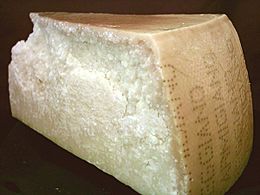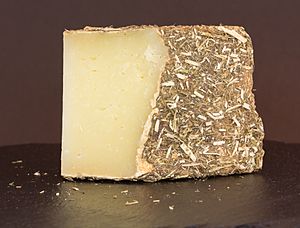Granular cheese facts for kids
Quick facts for kids Granular cheese |
|
|---|---|

|
|
| Country of origin | Multiple |
| Source of milk | Cows |
| Pasteurised | Sometimes |
| Texture | Granular, usually hard |
| Aging time | Minimum: 2 months Usual: 12 months |
Granular cheese is a type of cheese that's also called stirred curd cheese or hard cheese. It's made by constantly stirring and draining a mix of curd (the solid part of milk) and whey (the liquid part).
This method creates many different kinds of cheese. Some famous examples include grana cheeses like Parmigiano-Reggiano (which you can see in the picture). Many granular cheeses are also used to make processed cheese. For example, American cheese often contains granular cheese, along with Cheddar cheese or Colby cheese.
Popular Granular Cheeses
Want to know some famous granular cheeses? Here are a few examples from around the world:

- Appenzeller from Switzerland
- Bergkäse from Austria, Germany, and Switzerland
- Cheddar from the United Kingdom
- Dubliner from Ireland
- Grana Padano from Italy
- Manchego from Spain
- Pecorino from Italy
How Granular Cheese is Made
Making granular cheese usually follows a special process. First, milk or cream is gently warmed. Sometimes, it's treated with hydrogen peroxide and catalase. This step helps to clean the milk.
Next, a special lactic acid-producing bacterial culture is added. This helps the milk to start changing. Then, clotting enzymes are added. These enzymes make the milk turn into a soft, solid mass. This solid mass is called curd.
The curd is then cut into smaller pieces. It is stirred and heated. This helps to separate the solid curd from the liquid whey. If you stir and heat for longer, the cheese will have more moisture and milkfat. This means you get more cheese!
After this, the cheese makers keep draining the whey and stirring the curd. This happens in a cycle until most of the liquid is gone. Once the curd is mostly dry, it is salted. Then, it is drained again and pressed into the shape we recognize as cheese.
If the original milk wasn't pasteurized (heated to kill germs), the cheese might need to be cured. Curing means letting the cheese age. A common way to cure it is to dry it on racks for about a week. After that, it might be waxed and put into cool storage until it's ready to eat.
What Granular Cheese Tastes Like
Granular cheese often has a rich and tangy flavor. If it's made from unpasteurized milk, it can be eaten after 60 days of curing. However, at this point, its flavor is usually very mild.
To get a stronger, sharper taste, the cheese needs to age longer. The flavor becomes sharpest after about 12 months of aging. This is usually when it's sold in stores. You might also notice small, gritty, crystalline spots in granular cheese. These are called cheese crystals and are a normal part of aged cheese.

